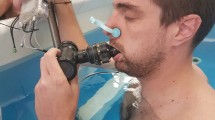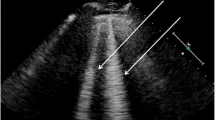Abstract
Purpose
Prolonged exposure to a high partial pressure of oxygen leads to inflammation of pulmonary tissue [pulmonary oxygen toxicity (POT)], which is associated with tracheobronchial irritation, retrosternal pain and coughing, and decreases in vital capacity (VC). The nitric oxide (NO) concentration in exhaled gas (FeNO) has been used as an indicator of POT, but the effect of SCUBA diving on FeNO has rarely been studied. The study presented here aimed to assess alterations to pulmonary function and FeNO following a 12-h dive using breathing apparatus with a relatively high partial pressure of oxygen.
Methods
Six healthy, male, non-smoking military SCUBA divers were recruited (age 31.8 ± 2.7 years, height 179 ± 0.09 cm, and body weight 84.6 ± 14 kg). Each diver completed a 12-h dive using a demand-controlled semi-closed-circuit rebreather. During the 12 h of immersion, divers were subjected to 672 oxygen toxicity units (OTU).
A complete pulmonary function test (PFT) was completed the day before and immediately after immersion. FeNO was measured using a Nobreath™ Quark (COSMED™, Rome, Italy), three times for each diver. The first datapoint was collected before the dive to establish the “basal state”, a second was collected immediately after divers emerged from the water, and the final measurement was taken 24 h after the dive.
Result
Despite prolonged inhalation of a hyperoxic hyperbaric gas mixture, no clinical pulmonary symptoms were observed, and no major changes in pulmonary function were detected. However, a major decrease in FeNO values was observed immediately after emersion [0–12 ppb (median, 3.8 ppb)], with a return to baseline [2–60 ppb (median, 26 ppb) 24 h later (3–73 ppb (median, 24.7 ppb)].
Conclusion
These results suggest that if the OTU remain below the recommended limit values, but does alter FeNO, this type of dive does not persistently impair lung function.



Similar content being viewed by others
Abbreviations
- ERV :
-
Expiratory reserve volume
- FEF 25–75%:
-
Forced expiratory flow 25–75%
- FeNO:
-
Concentration in exhaled nitric oxide
- FEV 1 :
-
Forced expiratory volume in 1 s
- FVC :
-
Forced vital capacity
- IRV :
-
Inspiratory reserve volume
- msw:
-
Meter sea water (is a unit of pressure used in underwater diving)
- NO:
-
Nitric oxide
- OTU:
-
Oxygen toxicity units (OTU)
- PEF:
-
Peak expiratory flow
- PFT:
-
Pulmonary function test
- POT:
-
Pulmonary oxygen toxicity
- ppb:
-
Parts per billion
- RV :
-
Residual volume
- SD:
-
Standard deviation
- TLC:
-
Total lung capacity
- TLCO :
-
Transfer factor for carbon monoxide
- UPTD:
-
Unit pulmonary toxic dose
- \(V_{C}\) :
-
Vital capacity
- \(V_{t}\) :
-
Tidal volume
References
Allen BW, Demchenko IT, Piantadosi CA (2009) Two faces of nitric oxide: implications for cellular mechanisms of oxygen toxicity. J Appl Physiol 106(2):662–667
Arieli R, Yalov A, Goldenshluger RP (2002) Modeling pulmonary and CNS O(2) toxicity and estimation of parameters for humans. J Appl Physiol (1985) 92(1):248–256
Berg JT, Deem S, Kerr ME, Swenson ER (2000) Hemoglobin and red blood cells alter the response of expired nitric oxide to mechanical forces. Am J Physiol Heart Circ Physiol 279(6):H2947–H2953
Bryan CL, Jenkinson SG (1988) Oxygen toxicity. Clin Chest Med 9(1):141–152
Caspersen C, Stensrud T, Storebo M, Thorsen E (2013) Exhaled nitric oxide and lung function after moderate normobaric hyperoxic exposure. Undersea Hyperb Med 40(1):7–13
Castagna O, Gempp E, Poyet R, Schmid B, Desruelle AV, Crunel V, Maurin A, Choppard R, MacIver DH (2017) Cardiovascular mechanisms of extravascular lung water accumulation in divers. Am J Cardiol 119(6):929–932
Catron PW, Bertoncini J, Layton RP, Bradley ME, Flynn ET Jr (1986) Respiratory mechanics in men following a deep air dive. J Appl Physiol (1985) 61(2):734–740
Clark JM (1988) Pulmonary limits of oxygen tolerance in man. Exp Lung Res 14(Suppl):897–910
Clark JM, Lambertsen CJ (1971a) Pulmonary oxygen toxicity: a review. Pharmacol Rev 23(2):37–133
Clark JM, Lambertsen CJ (1971b) Rate of development of pulmonary O2 toxicity in man during O2 breathing at 2.0 Ata. J Appl Physiol 30(5):739–752
Clark JM, Gelfand R, Lambertsen CJ, Stevens WC, Beck G Jr, Fisher DG (1995) Human tolerance and physiological responses to exercise while breathing oxygen at 2.0 ATA. Aviat Space Environ Med 66(4):336–345
Cucchiaro G, Tatum AH, Brown MC, Camporesi EM, Daucher JW, Hakim TS (1999) Inducible nitric oxide synthase in the lung and exhaled nitric oxide after hyperoxia. Am J Physiol 277(3):L636–644
Dujic Z, Eterovic D, Denoble P, Krstacic G, Tocilj J, Gosovic S (1993) Effect of a single air dive on pulmonary diffusing capacity in professional divers. J Appl Physiol (1985) 74(1):55–61
Dweik RA, Laskowski D, Abu-Soud HM, Kaneko F, Hutte R, Stuehr DJ, Erzurum SC, Erzurum SC (1998) Nitric oxide synthesis in the lung. Regulation by oxygen through a kinetic mechanism. J Clin Invest 101(3):660–666
Dweik RA, Boggs PB, Erzurum SC, Irvin CG, Leigh MW, Lundberg JO, Olin AC, Plummer AL, Taylor DR, Amercian Thoracic Society Committee on Interpretation of Exhaled Nitric Oxide Levels For Clinical (2011) An official ATS clinical practice guideline: interpretation of exhaled nitric oxide levels (FENO) for clinical applications. Am J Respir Crit Care Med 184(5):602–615
Geigel EJ, Hyde RW, Perillo IB, Torres A, Perkins PT, Pietropaoli AP, Frasier LM, Frampton MW, Utell MJ (1999) Rate of nitric oxide production by lower alveolar airways of human lungs. J Appl Physiol (1985) 86(1):211–221
Hamilton R, Kenyon DJ, Peterson R, Bees BGJD (1988) Repex habitat diving procedures: Repetitive vertical excursions, oxygen limits, and surfacing techniques. Technical Report Retrieved 29 Apnl 2008, pp 88–1 (A. Rockville, MD: NOAA Office of Undersea Research).
Kapanci Y, Tosco R, Eggermann J, Gould VE (1972) Oxygen pneumonitis in man., Light- and electron-microscopic morphometric studies. Chest 62(2):162–169
Kharitonov SA, Barnes PJ (2000) Clinical aspects of exhaled nitric oxide. Eur Respir J 16(4):781–792
Kharitonov SA, Barnes PJ (2001) Exhaled markers of pulmonary disease. Am J Respir Crit Care Med 163(7):1693–1722
Kjelkenes I, Thorsen E (2009) Time course of the reduction in nitric oxide concentration in exhaled gas after exposure to hyperbaric hyperoxia. Diving Hyperb Med 39(2):77–80
Klein J (1990) Normobaric pulmonary oxygen toxicity. Anesth Analg 70(2):195–207
Lemaitre F, Meunier N, Bedu M (2002) Effect of air diving exposure generally encountered by recreational divers: oxidative stress? Undersea Hyperb Med 29(1):39–49
Maziak W, Loukides S, Culpitt S, Sullivan P, Kharitonov SA, Barnes PJ (1998) Exhaled nitric oxide in chronic obstructive pulmonary disease. Am J Respir Crit Care Med 157(3 Pt 1):998–1002
Montgomery AB, Luce JM, Murray JF (1989) Retrosternal pain is an early indicator of oxygen toxicity. Am Rev Respir Dis 139(6):1548–1550
Paraskakis E, Brindicci C, Fleming L, Krol R, Kharitonov SA, Wilson NM, Barnes PJ, Bush A (2006) Measurement of bronchial and alveolar nitric oxide production in normal children and children with asthma. Am J Respir Crit Care Med 174(3):260–267
Pedoto A, Nandi J, Yang ZJ, Wang J, Bosco G, Oler A, Hakim TS, Camporesi EM (2003) Beneficial effect of hyperbaric oxygen pretreatment on lipopolysaccharide-induced shock in rats. Clin Exp Pharmacol Physiol 30(7):482–488
Pendergast DR, Lundgren CE (2009) The underwater environment: cardiopulmonary, thermal, and energetic demands. J Appl Physiol 106(1):276–283
Pendergast DR, Moon RE, Krasney JJ, Held HE, Zamparo P (2015) Human physiology in an aquatic environment. Compr Physiol 5(4):1705–1750
Prefaut C, Lupi-h E, Anthonisen NR (1976) Human lung mechanics during water immersion. J Appl Physiol 40(3):320–323
Puthucheary ZA, Liu J, Bennett M, Trytko B, Chow S, Thomas PS (2006) Exhaled nitric oxide is decreased by exposure to the hyperbaric oxygen therapy environment. Mediators Inflamm 2006(5):72620
Robinson FR, Casey HW, Weibel ER (1974) Animal model: oxygen toxicity in nonhuman primates. Am J Pathol 76(1):175–178
Sackner MA, Landa J, Hirsch J, Zapata A (1975) Pulmonary effects of oxygen breathing. A 6-hour study in normal men. Ann Intern Med 82(1):40–43
Schmetterer L, Strenn K, Kastner J, Eichler HG, Wolzt M (1997) Exhaled NO during graded changes in inhaled oxygen in man. Thorax 52(8):736–738
Shykoff BE (2005) Pulmonary effects of submerged oxygen breathing: 4-, 6-, and 8-hour dives at 140 kPa. Undersea Hyperb Med 32(5):351–361
Smith JL (1899) The pathological effects due to increase of oxygen tension in the air breathed. J Physiol 24(1):19–35
Taraldsoy T, Bolann BJ, Thorsen E (2007) Reduced nitric oxide concentration in exhaled gas after exposure to hyperbaric hyperoxia. Undersea Hyperb Med 34(5):321–327
Thom SR (2011) Hyperbaric oxygen: its mechanisms and efficacy. Plast Reconstr Surg 127(Suppl 1):131S–141S
Thorsen E, Segadal K, Reed JW, Elliott C, Gulsvik A, Hjelle JO (1993) Contribution of hyperoxia to reduced pulmonary function after deep saturation dives. J Appl Physiol (1985) 75(2):657–662
Thorsen E, Aanderud L, Aasen TB (1998) Effects of a standard hyperbaric oxygen treatment protocol on pulmonary function. Eur Respir J 12(6):1442–1445
van Ooij PJ, Houtkooper A, van Hulst R (2010) Variations in exhaled nitric oxide concentration after three types of dives. Diving Hyperb Med 40(1):4–7
van Ooij PJ, van Hulst RA, Houtkooper A, Sterk PJ (2011) Differences in spirometry and diffusing capacity after a 3-h wet or dry oxygen dive with a PO(2) of 150 kPa. Clin Physiol Funct Imaging 31(5):405–410
van Ooij PJ, Hollmann MW, van Hulst RA, Sterk PJ (2013) Assessment of pulmonary oxygen toxicity: relevance to professional diving; a review. Respir Physiol Neurobiol 189(1):117–128
van Ooij PJ, van Hulst RA, Houtkooper A, Sterk PJ (2014) Nitric oxide and carbon monoxide diffusing capacity after a 1-h oxygen dive to 9 m of sea water. Clin Physiol Funct Imaging 34(3):199–208
Wright W (1972) Use of the University of Pennsylvania, Institute for Environmental Medicine Procedure for calculation of cummulative pulmonary oxygen toxicity. Navy Experimental Diving Unit, Washington, DC
Acknowledgements
We thank B. Schmid, Engineer, for his invaluable contribution to this work.
Funding
Not applicable.
Author information
Authors and Affiliations
Contributions
OC, CB and JEB conceptualized and designed the study, performed the experiments, analyzed the data, interpreted the results of experiments, and prepared the figures. OC and JEB drafted, edited, and revised the manuscript. OC, CB and JEB approved the final version of the manuscript.
Corresponding author
Ethics declarations
Conflict of interest
The authors have no competing interests to disclose in relation to this study. The results of the present study do not constitute endorsement by the European JAP, and are presented clearly, honestly, and without fabrication, falsification, or inappropriate data manipulation.
Additional information
Communicated by Susan Hopkins.
Publisher's Note
Springer Nature remains neutral with regard to jurisdictional claims in published maps and institutional affiliations.
Rights and permissions
About this article
Cite this article
Castagna, O., Bergmann, C. & Blatteau, J.E. Is a 12-h Nitrox dive hazardous for pulmonary function?. Eur J Appl Physiol 119, 2723–2731 (2019). https://doi.org/10.1007/s00421-019-04248-w
Received:
Accepted:
Published:
Issue Date:
DOI: https://doi.org/10.1007/s00421-019-04248-w




